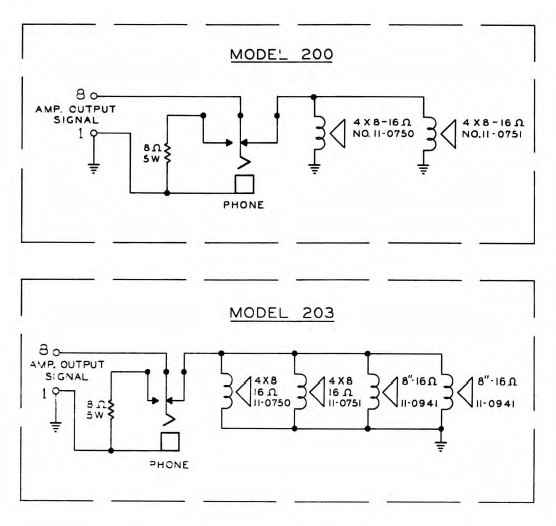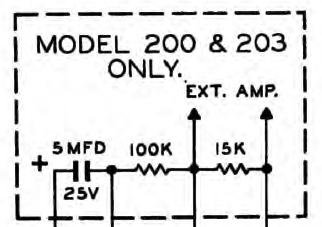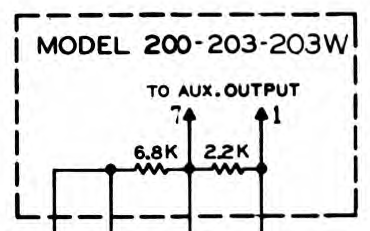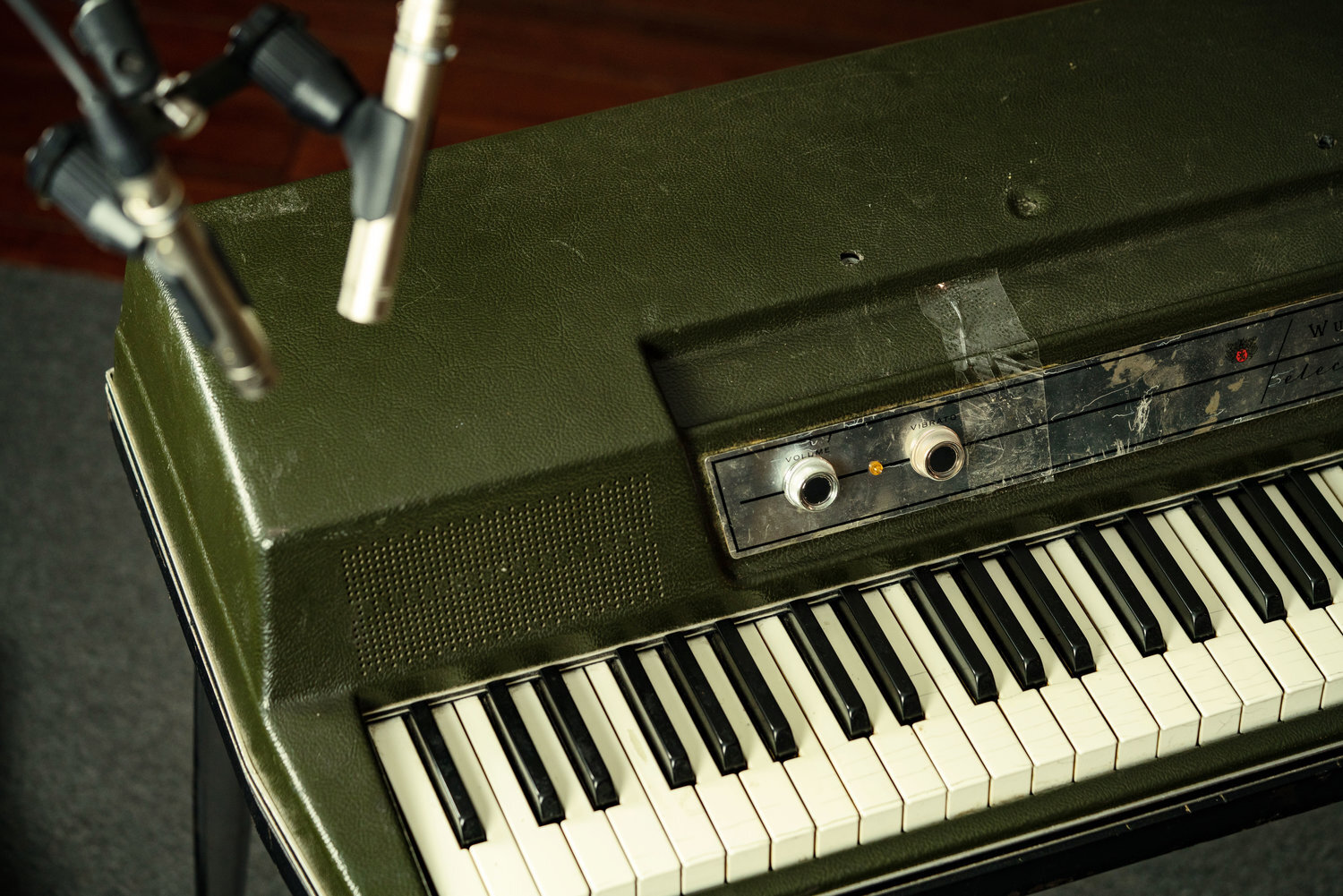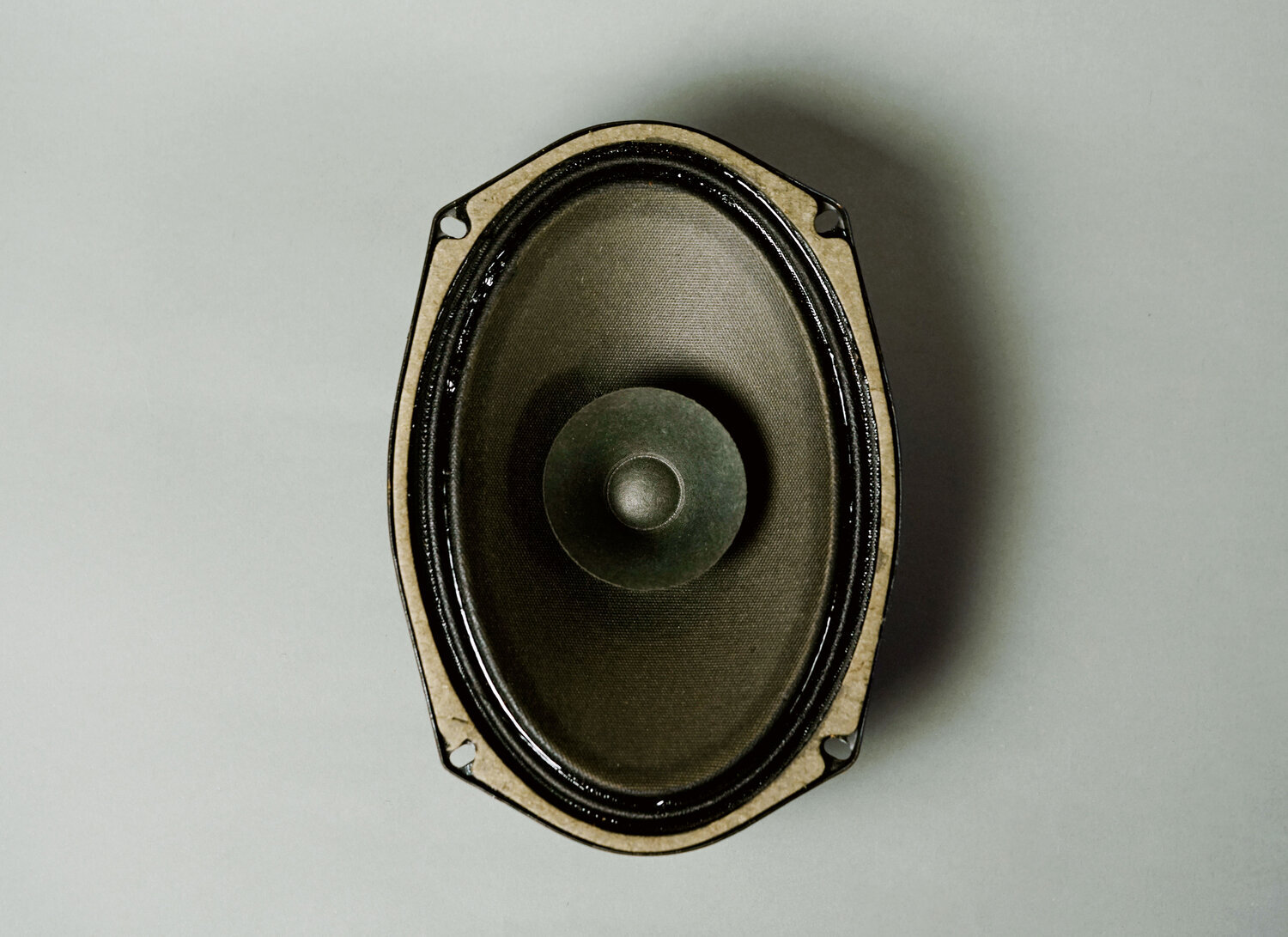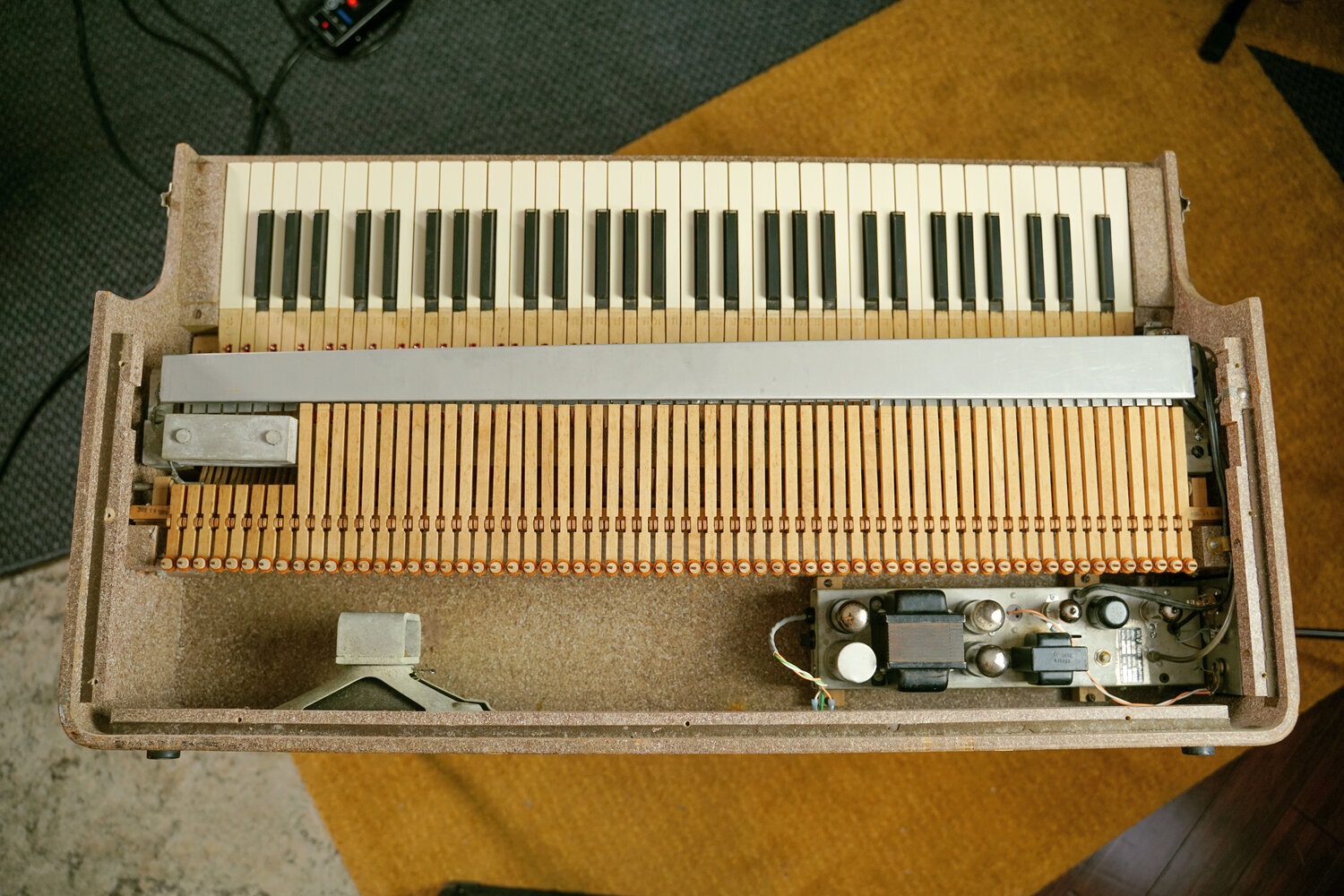What is the difference between a Wurlitzer's headphone output and aux output?
Although both the Wurlitzer’s headphone out and aux out are (obviously) outputs, they tap the signal from very different points in the circuit. In this article, we’ll describe the differences between the two outputs, so that you can choose which one is better for your application.
The most usable Wurlitzer aux outputs are on the latest models: the 200 and the 200a. Other Wurlitzer keyboards either have a weird, unusable, obsolete jack for the aux out (the 112) or have no output at all (pretty much every other model). We will talk about early Wurlitzer aux outputs in another article, and focus here on the 200 and 200a. (In the meantime, if you have questions about the aux output in 100-series Wurlitzers, you can ask us via the Wurly Hotline.)
Understanding an Amplifier’s Signal Path
To appreciate the difference between an aux out and a headphone out, you should first have a working knowledge of the signal path of an amplifier. Just about every amplifier, both tube and solid state, has two main sections: the preamp and the power amp. An aux output takes a line-level signal from the preamp, while the headphone out is typically found in parallel to the speaker output at the end of the power amp.
The output jack in this photo is partially obscured, because it is mounted underneath the amp rail.
When you hit a key on the Wurlitzer, the motion of the reed works in concert with the pickup to create an extremely weak electrical signal. The preamp boosts this signal to a usable level that is appropriate for the power amplifier. The preamp is also where tone-shaping happens. Here, the amplifier might boost or roll off certain frequencies, or add a strategic amount of distortion. You can often identify the preamp circuit visually, because it contains small-signal tubes, such as those in the 12AX7 family, or small transistors.
Once the signal passes through the preamplifier, it moves to the power amplifier circuit. The main job of the power amplifier is to increase the signal further, to a level that is appropriate for driving speakers. The power amplifier can also add color and distortion, but the designer has more control over those factors in the preamp. Power amplifier devices include large tubes such as 6V6s or 6L6s, or larger transistors that often require a heat sink.
Amplifiers need a preamp and power amp section because the signal sounds better when it is boosted incrementally. If you try to boost the signal too much at once, you’ll end up with a ton of noise and so much clipping that your audio will probably be unrecognizable. It is also difficult to effectively drive a speaker unless you first amplify the signal with multiple gain stages.
At any point in the amplifier circuit, you can take the signal out and send it to another device via the jack. How you do this, specifically, affects the quality of the signal, but that’s outside the scope of this article. The main difference between the headphone jack and the aux output is this: the aux output takes the signal from the preamp, and the headphone jack takes the signal from he power amp.
If you take the signal from the preamp, the result is a line-level signal. This is a medium-sized signal that will have the characteristics of the preamp — whatever those may be — but not necessarily those of the power amp. Preamp signal is lower-level and often much cleaner than the final, post-power-amp signal. You can send this signal to another amplifier, and, although it will be hotter than a typical unamplified instrument signal, there is still a lot of room for the second amplifier to provide shaping and drive.
In contrast, the headphone jack takes its signal from the power amp — typically at the very end of the signal chain, in parallel with the speakers. Here, the signal is generally hotter, because it already has been fully amplified by the entire circuit. It may need to be attenuated before it is sent to another amplifier. It may also be noisier.
In many cases, however, the headphone output can be used similarly to a line-level signal. You can usually send it to a mixer or a preamplifier. However, this all depends on the particulars of the circuit: to safely send a headphone output to a line-level device, the voltage of the output should be pretty low. This is often the case, but it varies from amplifier to amplifier. For this reason, you should be particularly cautious when connecting an unknown headphone out to your mixer or preamp. Some basic precautions: start with the volume level on zero, use a DI box with the pad engaged, and don’t use your most expensive preamps as test devices.
To summarize…
The headphone jack…
Taps the signal from the end of the power amp (late in the circuit)
Outputs a speaker-level signal
Has a low-impedance output
Is optimized to drive headphones, but can often be connected to a device that expects a line level signal
May have distortion and/or noise if connected to a line-level device
While the aux output…
Taps the signal from the preamp (early in the circuit)
Outputs a line-level signal
Usually low-impedance, but could be high impedance depending on the design
Optimized to drive a line-level device, and cannot drive speakers or headphones
Is designed for low distortion and low noise
How the headphone and aux out works in the Wurlitzer 200 and 200a
The Wurlitzer 200 and 200a have the same style of headphone output, but their aux circuits are very different. The 200 is earlier than the 200a, and its aux circuit is extremely rudimentary. We wish we could blame the 200’s earlier manufacture, but the 112 had a decent aux output, and it was released nearly 15 years earlier. Anyway, the 200’s aux has a low output and is often noisy. In contrast, the 200a has a relatively sophisticated aux that provides a level of pre-amplification before sending the signal to the jack.
How Wurlitzer 200 and 200a headphone jacks work. The headphone jack on both the Wurlitzer 200 and 200a is a switching jack. With no headphones connected, the amplifier sends the signal directly to the speakers. However, when headphones are connected, the presence of the 1/4” plug in the jack physically disconnects the speaker connection. This takes the speakers out of circuit, so that when you are using headphones you will not hear the speakers.
The headphone jack has an 8 Ω load resistor. This resistor simulates the impedances of the speakers when they are disconnected by the switching jack. This keeps the amplifier’s load impedance approximately in the realm of 8 Ω when a higher-impedance device, such as headphones or a DI box, is connected to the headphone jack.
Connecting the 200/200a headphone jack to a mixer. When connecting the headphone jack to a mixer, you should use a passive DI box. A DI box provides a measure of isolation between the two devices by blocking unwanted DC currents. Many DI boxes also have an attenuation feature.
How the Wurlitzer 200 and 200a aux outputs work. Although the 200 is earlier and slightly more primitive than the 200a, there is still a lot of reasons to love the sound of it (alnico speakers, anyone?). Its aux output, however, is not one of those reasons. The 200a has an entire circuit dedicated to amplifying its aux output signal. The 200 taps a random place in the preamp using two resistors and a wire. Although this voltage divider certainly gets the signal out of the amplifier and into your recording device, the result is low-level and often noisy.
Wurlitzer experimented with a few variations on the 200 output circuit, and determined that a voltage divider using a 6.8k and a 2.2k resistor was their preferred solution. The original 200 output circuit used 100k and 15k resistors in the voltage divider, as well as a 5 uf coupling cap. If your 200 has an earlier amplifier, and you are dissatisfied with the aux output, you should try converting it to later specs by replacing the 5 uf capacitor with a wire and swapping the 100k and 15k resistors for 6.8k and 2.2k, respectively.
You can tell at a glance whether your amp has the new or old aux out. If you have an electrolytic capacitor connected to two pins on the edge of the board, closest to the keys, you have the old aux out. If you have no capacitor, there will be a wire connecting those pins instead.
The Wurlitzer 200a aux output is much more elaborate than the 200 aux output (shown above).
Connecting the 200/200a aux outputs to a mixer. Because the 200’s aux circuit is so bare-bones, it requires a preamp for a usable level. Due to the lack of coupling capacitor (which is typically included to block any stray DC currents) in most 200 aux circuits, a DI box should also be used. Although the 200a has a more robust aux, a preamp will typically allow you to get better results here as well.
How do I tell the difference between the headphone jack and the aux output? In most Wurlitzers, these outputs are labeled (although you need to pretty much crawl underneath the Wurlitzer to see). However, some Wurlitzers might not have labeled outputs: for instance, student Wurlitzers that were converted to 200/200a specs. Student models did not originally have an aux output — only a headphone jack — so they do not have the same labeling as a regular 200 or 200a.
Regardless of whether the outputs are labeled, you can typically tell which is which because the headphone jack will cut the speakers and the aux output will not. Or, you can take the lid off and trace the circuit according to the layout drawings in the service manual. One quick way to visually tell the difference between the two jacks: the headphone out will have a large 8Ω/5W resistor connected to it, and the aux output will not.
When should I use the headphone jack, and when should I use the aux output? Ideally, you should use the headphone jack only when you are connecting headphones, and the aux output when connecting to pretty much anything else (mixers, preamplifiers, etc). However, there are circumstances where you may be tempted to use the headphone jack:
You want to cut the speakers while you are recording. The aux output cuts the speakers, while the headphone jack does not. There may be circumstances where you want to record with the speakers off, and the headphone jack is certainly a convenient way to achieve that. An alternative is to connected the aux output to your interface, and cut the speakers by connecting headphones to the headphone jack.
You prefer the sound of the headphone output to the aux output. The headphone output definitely takes the signal from a different point than the aux out, so, if you truly like the headphone out sound better, we won’t argue with your preference. However, if you don’t like the sound of your aux output because there is something wrong with it, you should resolve that problem before writing off the aux entirely. To that end, our next section discusses troubleshooting.
How to tell if your Wurlitzer’s aux output is working properly
This amplifier is from a student-model Wurlitzer 206, so the aux is disconnected in the photo. The upside of having such as simplistic aux is that it is very easy to hook up a 200-style aux output in a student 206 that doesn’t have one. More on how to do that here.
First of all, is the jack isolated? Both the Wurlitzer 200 and 200a aux output jacks should be isolated from the wooden cabinet (i.e., the base of the Wurlitzer where they are mounted). This is because the inside of your Wurlitzer is painted with conductive paint. If the jack’s ground is mounted directly to this paint, it could create a ground loop with the device that you connect to it. This would introduce noise into the signal.
The original jacks that Wurlitzer used were isolated. They are square in shape and made of black plastic. However, if they were ever replaced, it is possible that the new jacks are not isolated. Note that you can also use regular jacks here if you use an isolation washer.
Second, what is the general condition of the amplifier? The aux output will only sound as good as the signal that it is given. If your amplifier has leaky electrolytic coupling capacitors, deteriorated carbon resistors, and other issues, the aux is not working to its full potential.
Recording with the aux output basically puts the preamp under a microscope. Flaws that might be acceptable through the speakers, in the context of a performance occurring in an actual room, may become much more obvious when monitoring through your DAW. If your amplifier is not in great shape to begin with, you will definitely hear it in the recording.
For this reason, you should perform basic maintenance on the amplifier before attempting to troubleshoot the aux circuit (or, for that matter, cast judgement on its poor audio quality).
What does a working Wurlitzer 200 aux output sound like? Because the original 200 aux circuit is so minimal, the signal will be very quiet. It will also very likely have an audible hum. The hum can be reduced by replacing deteriorated components (including electrolytic capacitors) and otherwise performing maintenance on the circuit. If you have an early amplifier, swapping the original aux circuit components for the updated 6.8k/2.2k values may help. To get a usable result from your 200 aux output, the amplifier circuit needs to be in excellent overall condition.
For best results, you should always use a DI box and a preamp when recording with the 200 aux output. The preamp will boost the signal to a usable level without adding noise. If you connect the Wurlitzer straight to your mixer or interface without a preamp, you will probably have to really crank the Wurlitzer’s volume. This will add an avoidable amount of noise.
What does a working 200a aux output sound like? In contrast, a 200a aux output in good condition will produce a strong signal with no additional noise. If you hear more noise from the output than from the speakers, it is safe to say that something in the amplifier has deteriorated and/or is malfunctioning. Likewise, if your 200a’s aux output is weak, there is probably something wrong with the aux circuit. Although a preamp can be used as needed to help boost the level and warm up your Wurlitzer’s tone, it is not necessary to bring the 200a aux output to a level usable for reacording.
If the speaker output sounds good and only the aux has issues, you should focus your attention on the circuitry in the aux circuit. More information on reducing hum can be found here and here.
Further Reading
Browse all of our articles on restoring vintage gear. Or, click on an image below.



